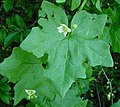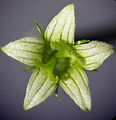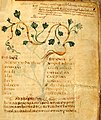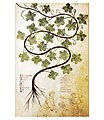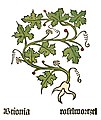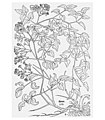Red-fruited bryony
| Red-fruited bryony | ||||||||||||
|---|---|---|---|---|---|---|---|---|---|---|---|---|

Red-fruited bryony Bryonia dioica , drawing from Germany's flora in illustrations by Johann Georg Sturm |
||||||||||||
| Systematics | ||||||||||||
|
||||||||||||
| Scientific name | ||||||||||||
| Bryonia dioica | ||||||||||||
| Jacq. |
The Bryonia dioica , Red Bryony or dioecious Bryony ( Bryonia dioica Jacq. , Syn. Bryonia cretica subsp. Dioica (Jacq.) Tutin ) is a domestic in Central Europe plant species from the family of cucurbits (Cucurbitaceae). Other common names are red berry bryony and red bryony. The whole plant, especially the ripe fruits and the roots, are poisonous.
description
The red-fruited bryan is a perennial plant with a thickened, beet-like root . The climbing stems are 2 to 4 meters long and branchy. The stem is rough due to the pointed nodules and short bristles. The tendrils are simple.
The leaves are stalked short, have a diameter of up to 10 centimeters and a pentagonal outline. They are coarse hairy on both sides and five-lobed palmate up to the middle. The lobes are triangular to elliptical, the middle one is only slightly larger than the rest. The leaf margin has entire or slightly blunt serrations.
The species is diocesan , so there are single plants with either male or female flowers . The flower stalks are hairy glands. The male flowers are green and 6 millimeters long, their calyx is half as long as the crown . The crown of the female flowers is around 10 millimeters wide. Their color is greenish-white, their scar is rough-haired. The flowers produce nectar . The flowering period lasts from June to September.
The berries are green when unripe and then turn scarlet. They are 6 to 7 millimeters in diameter and spherical.
The number of chromosomes is 2n = 20.
Distribution and locations
The red-fruited brychid is native from Europe to West Asia, its area is characterized as meridional to southern temperate. In Central Europe it is widespread in the south, rarely in northern Germany, and in some cases, including Denmark, only immigrated as a neophyte . In Austria it is common in the Pannonian region , otherwise scattered or rare.
It grows in hedges and riparian forests on fresh, nutrient-rich, loose loam soils. It occurs up to the colline, rarely up to the montane elevation . She is an Alliarion federation character.
Insect plant
The red-fruited bryan beet and the black-fruited bryan beet are the sole food plants for the bryony sand bee ( wild bee of the year 2015). It feeds on the nectar of the bryony flowers and collects the pollen for its brood.
The bug ladybird feeds on the leaves of the brychid as well as other cucurbits .
Picture gallery
history
Antiquity - late antiquity. In the 1st century, Dioscurides and Pliny reported identically about a “white vine” ( vitis alba ) with yellow fruits and about a “black vine” ( vitis nigra ) with initially green and later black fruits. They attributed the same effects to both plants. The "white vine" should, however, appear stronger than the "black vine". Later, both plants were mostly interpreted as bryony species .
According to Dioscurides and Pliny, the young shoots, cooked and eaten as vegetables, should stimulate urination and stool excretion . Fruits, roots and leaves should be taken internally against epilepsy, be indicated after snakebite , drive out the birth and afterbirth and soften the "spleen", whereby "spleen" is not to be understood as a concept of anatomy, but as a concept of the theory of humors . Ingested, the root should help with mental illness . But it could also attack the mind itself. Also inserted into the vagina, the root should pull out birth and afterbirth. Taken with honey, preparations made from “vitis alba” and “vitis nigra” should be effective against suffocation, shortness of breath and coughing. Fruits, roots and leaves were used externally against skin spots , against ulcers and to open abscesses . The juice of the stems should stimulate milk secretion . Galen adopted this information in the 2nd century .
In late antiquity, the Pseudo-Apuleius (4th – 6th centuries) cited only a "softening of the hardened spleen" as the effect of herba brionia - vitis alba . The (pseudo-) Dioscorides de herbis feminis (6th century) interpreted the vitis nigra as a female and the vitis alba as a male plant.
Arabic and Latin Middle Ages. The Arab doctors - including Avicenna - cited Galen's remarks.
The “Spuria Macri” from the 11th century, an appendix to the didactic poem “ Macer floridus ”, which was widespread in the Middle Ages , contains a chapter on “bryonia”, which is fed from the corresponding information in Dioscurides and Pliny.
In the Physica manuscripts from the 14th to 15th centuries attributed to Hildegard von Bingen , the beet was called "Stichwurtz" and referred to as a poisonous "weed", which, however, is good for neutralizing other poisons and keeping poisonous animals away. A decoction of the root should be effective as a poultice against foot tumor.
In a 15th-century Lower Alemannic drug compilation from Ravensburg, the white vine was called "lieri" and "liena". The powder of the herb sprinkled into the wounds should help them heal. If there is pain in the forehead or eye area, the top bark should be scraped off and discarded. The following bark should be tied under the chin on the disease side. The resulting skin blister would clear the disease (the "addicted").
In the earliest prints of the herbal books , the ancient authors' descriptions of two Bryonia species were either summarized in one chapter ( Herbarius Moguntinus 1484 and Kleines Distillierbuch 1500) or divided into two chapters: "brionia" and "viticella" ( Gart der Gesundheit 1485 and Hortus sanitatis 1491)
Modern times. Hieronymus Bock gave an exact botanical description of Bryonia dioica in his New Kreütter book in 1539 . Leonhart Fuchs "interpreted" the vitis alba of the ancients as Bryonia dioica Jaqc in 1542/43. the vitis nigra the elderly as Clematis L. vitalba .
Until the 19th century, preparations made from bryan roots were mainly used externally to clean wounds , and to a lesser extent internally as a very energetic laxative and wormer .
Chemical Analysis. Louis-Nicolas Vauquelin examined the bryony root at the beginning of the 19th century and described a substance it contained that was later called "bryonin". This "bryonine" was examined more closely in 1858 by Georg Friedrich Walz .
Toxicology. Mathieu Orfila , the founder of toxicology in the 19th century, devoted an entire chapter in his "Treatise on Poisons" to the brychus root in 1815, evaluating animal experiments and human poisoning. Jonathan Pereira , AWM van Hasselt and Louis Lewin made further contributions to the toxicology of the bryony root .
swell
- Antiquity - late antiquity: Dioscorides 1st century --- Pliny 1st century --- Galen 2nd century --- Pseudo-Apuleius 4th century --- Pseudo-Dioscorides de herbis femininis . 6th century
- Arab Middle Ages: Avicenna 11th century --- Pseudo-Serapion 13th century --- Ibn al-Baitar 13th century
- Latin Middle Ages: Hildegard von Bingen 12th century --- Cod. P. 386 (1463–1466) --- Herbarius Moguntinus 1484 --- Garden of Health 1485 --- Hortus sanitatis 1491 --- Hieronymus Brunschwig 1500
- 16th century: Hieronymus Bock 1539 --- Leonhart Fuchs 1542 --- Leonhart Fuchs 1543 --- Mattioli / Handsch / Camerarius 1586
- 17th - 18th century: Nicolas Lémery 1699/1721 --- Onomatologia medica completa 1755
- 19th century: Hecker 1814/15 --- Encyclopedic Dictionary 1831 --- Theodor Husemann 1883
- Chemical analysis: Vauquelin 1807 --- Georg Friedrich Walz 1858
- Toxicology: Mathieu Orfila 1815 --- Pereira / Buchheim 1848 --- van Hasselt / Husemann 1862 --- Louis Lewin 1885
Historical illustrations
Viennese Dioscurides 6th century, white vine
Vienna Dioscurides 6th century, black vine
Pseudo-Apuleius Leiden 6th century
Pseudo-Apuleius Vienna 14th century
Pseudo-Dioscurides de herbis femininis 14th century manuscript
Herbarius Moguntinus 1484
Garden of Health 1485 Brionia
Gart der Gesundheit 1485 Viticella
Leonhart Fuchs 1543 Stickwurtz
Leonhart Fuchs 1543 Lynen
Hieronymus Bock 1546
Mattioli / Handsch / Camerarius 1586
swell
literature
- Rolf Wisskirchen, Henning Haeupler: Standard list of fern and flowering plants in Germany. With chromosome atlas . Ed .: Federal Agency for Nature Conservation (= The fern and flowering plants of Germany . Volume 1 ). Eugen Ulmer, Stuttgart (Hohenheim) 1998, ISBN 3-8001-3360-1 .
- Ingrid Schönfelder, Peter Schönfelder : The new manual of medicinal plants. Franckh-Kosmos, Stuttgart 2004, ISBN 3-440-09387-5 .
- Karl Hiller, Matthias F. Melzig: Lexicon of medicinal plants and drugs. 2nd Edition. Spektrum Akademischer Verlag, Heidelberg 2010, ISBN 978-3-8274-2053-4 .
- Siegmund Seybold (Ed.): Schmeil-Fitschen interactive . CD-ROM, version 1.1. Quelle & Meyer, Wiebelsheim 2002, ISBN 3-494-01327-6 .
Individual evidence
- ↑ a b Erich Oberdorfer : Plant-sociological excursion flora for Germany and neighboring areas. 8th edition. Verlag Eugen Ulmer, Stuttgart 2001, ISBN 3-8001-3131-5 , p. 678.
- ^ Rudolf Schubert , Klaus Werner, Hermann Meusel (eds.): Exkursionsflora for the areas of the GDR and the FRG . Founded by Werner Rothmaler. 13th edition. tape 2 : vascular plants . People and knowledge, Berlin 1987, ISBN 3-06-012539-2 , pp. 197 .
- ^ Manfred A. Fischer, Karl Oswald, Wolfgang Adler: Excursion flora for Austria, Liechtenstein and South Tyrol . 3rd, improved edition. Province of Upper Austria, Biology Center of the Upper Austrian State Museums, Linz 2008, ISBN 978-3-85474-187-9 , p. 464 .
- ↑ Bryony Sand Bee ( Andrena florea )
- ↑ Janus Cornarius . Macri De materia medica . Frankfurt 1540 (digitized version)
- ↑ Ulrike Jansen. Spuria Macri. An appendix to Macer Floridus, De viribus herbarum. Introduction - translation - commentary . de Gruyter, Berlin & Boston 2013, ISBN 978-3-11-030849-5 .
- ↑ Hermann Fischer . Medieval botany . Verlag der Münchner Drucke, Mündhen 1929, p. 262: Bryonia ... liela, zitwurz (Gloss.). Heinrich Marzell . Dictionary of German plant names . S. Hirzel, Leipzig 1943, Volume I, Col. 1047: Clematis vitalba ... liela, liene, lienle ... Some of the lemmas point to Bryonia. Willem Frans Daems . Nomina simplicium medicinarum ex synonymariis medii aevi collecta. Semantic studies of the specialist vocabulary of high and late medieval drug studies . EJ Brill, Leiden - NY - Cologne 1993, p. 265 (No 475): Viticella liel ... Bryonia. P. 280 (No 523): Brionia vitis alba idem wilt wingaert of leyl. P. 332 (No 754): Vitis alba brionia idem leyl
- ↑ Pedanios Dioscurides . 1st century: De Medicinali Materia libri quinque. Translation. Julius Berendes . Pedanius Dioscurides' medicine theory in 5 books. Enke, Stuttgart 1902, pp. 469-470 (Book IV, Chapter 181): Weisser Ampelos (digitalisat) ; P. 470–471 (Book IV, Chapter 182): Schwarzer Ampelos (digitized version )
- ↑ Pliny the Elder , 1st century: Naturalis historia book XXIII, chapters xvi – xvii (§ 21–28): Vitis alba. Vitis nigra (digitized version) ; Translation Külb 1855 (digitized version )
- ↑ Galen , 2nd century. De simplicium medicamentorum temperamentis ac facultatibus , Book IV, Chapter I / 34 (based on the Kühn 1826 edition, Volume XI, pp. 826–827): Vitis alba (digitized version ) ; Chapter I / 35 (based on the Kühn 1826 edition, Volume XI, p. 827): Vitis nigra (digitized version)
- ↑ First printing: Rome 1481, Chapter 69: Herba Breonia (digitized version )
- ↑ Pseudo-Dioscorides de herbis femininis . 6th century edition: HF Kästner. Pseudo-Dioscorides de herbis femininis. In: Hermes , Vol. 31 (1896), pp. 606–607 (Chapter 26): Melena (Vitis nigra) (digitized version )
- ↑ Avicenna , 11th century: Canon of Medicine . Translation and adaptation by Gerhard von Cremona , Arnaldus de Villanova and Andrea Alpago (1450–1521). Basel 1556, Volume II, Chapter 269: Vitis alba ; Chapter 270: Vitis nigra (digitized version)
- ^ Pseudo-Serapion 13th century, print. Venice 1497, sheet 105r (No XXXVII and XXXVIII): Vitis alba and Vitis nigra (digitized version )
- ↑ Abu Muhammad ibn al-Baitar , 13th century, Kitāb al-jāmiʿ li-mufradāt al-adwiya wa al-aghdhiya. Translation. Joseph Sontheimer under the title Large compilation on the powers of the well-known simple healing and food. Hallberger, Stuttgart Volume II 1842, pp. 242–243 (digitized version )
- ^ Charles Victor Daremberg and Friedrich Anton Reuss (1810–1868). S. Hildegardis Abbatissae Subtilitatum Diversarum Naturarum Creaturarum Libri Novem. Physica , Book I, Chapter 43: Stichwurtz . Migne, Paris 1855. Sp. 1146 (digitized version ) : Translation: Herbert Reier: Hildegard von Bingen Physica. Translated into German after the text edition by JP Migne, Paris 1882. Kiel 1980, p. 87: The Stichwurtz is warm and unsuitable for human use as it is unkrut because it is useless. Their warmth is dangerous, but not where poison is prepared. Because if it is ignited in the fire, so that its warmth and smell touch the poison, it diminishes its strength, just as wine loses its strength if it remains in a mug for one night. And when it is held in the fire like a turnip, and then taken from the fire while heated and cut into pieces, it gives off a scent. And when this smell touches a snake or a poisonous frog, it damages it so that the snake foams and the frog suffers so much that it flees from the place. If the smell touches a person, it causes him pain if he has not previously eaten diamond. Because it then has so unworthy and annoying juices in it that the human being perishes of bad worms. If a person's feet are broken by ulcers, they boil stichwurtz in water and, after squeezing out the water, place the stichwurtz so warm on the exhausted feet and move them with it. Then the tumor disappears and he becomes healthy.
- ↑ Solothurn, Cod. P. 386, Niederalemannisch, 1463–1466, sheets 52v – 53r (digitized version ) : Bionia that is dü lieri or dü wiss reb and grows in the hedgerows in the midst of it grows ain the same that is rass that accompanies the wounds haillen wöl der puluer das crutt vnd tůge das dar in so enhailet sÿ nit da och worm in sint der nem die wurcz with honey vnd drink sy with warm water vnd pour sÿ to die sere dying all . Sheet 68r – 68v (digitized version ) : ... To whom the addiction in the forehead as in the eyes we tügi the nem liena and scrape off the roast beef and throw the beef back and scrape the vndren and bint are bang the chin or shut the manners there in we sÿ so innkeeper ain blatter da vnd reproaches the addiction uss ...
- ↑ Herbarius Moguntinus , Mainz 1484, Part I, Chapter 31: Brionia. Roselwortzel (digitized version )
- ↑ Gart der Gesundheit . Mainz 1485, Chapter 68: Brionia (digitized version ) ; Chapter 425: Viticella (digitized version )
- ↑ Hortus sanitatis 1491, Mainz 1491, Part I, Chapter 75: Brionia (digitized version ) ; Chapter 497: Viticella (digitized version )
- ↑ Hieronymus Brunschwig : Small distilling book , Strasbourg 1500, sheet 123r: Wild Zytwan (digitized version )
- ↑ Hieronymus Bock : New Kreütter Bůch . Wendel Rihel, Strasbourg 1539, Part II, Chapter 93: Hundskürbs. Bryonia (digitized version )
- ↑ Leonhart Fuchs . De historia stirpium. Michael Isengrin, Basel 1542, p. 94–96: Ampelos leuce , p. 96–98 Ampelos melaena (digitized version )
- ↑ Leonhart Fuchs: New Kreütterbuch… Michael Isingrin, Basel 1543, chapter 32: Stickwurtz (digitized version ) ; Chapter 33: Lynen (digitized version)
- ^ Pietro Andrea Mattioli : Commentarii, in libros sex Pedacii Dioscoridis Anazarbei, de medica materia. Translation by Georg Handsch, edited by Joachim Camerarius the Younger , Johan Feyerabend, Franckfurt am Mayn 1586, sheet 443v – 444v: Stickwurtz (digital copy )
- ↑ Nicolas Lémery : Dictionnaire universel des drogues simples. , Paris 1699, p. 118: Bryonia (digitized version ) ; Translation. Complete material lexicon. Initially drafted in French, but now after the third edition, which has been enlarged by a large [...] edition, translated into high German / By Christoph Friedrich Richtern, [...]. Leipzig: Johann Friedrich Braun, 1721, Sp. 186–187: Bryonia (digitized)
- ↑ Albrecht von Haller (editor): Onomatologia medica completa or Medicinisches Lexicon which explains all names and artificial words which are peculiar to the science of medicine and the art of pharmacy clearly and completely [...]. Gaumische Handlung, Ulm / Frankfurt am Main / Leipzig 1755, Sp. 238–241: Bryonia (digitized version )
- ↑ August Friedrich Hecker 's practical medicine theory. Revised and enriched with the latest discoveries by a practicing doctor . Camesius, Vienna, Volume I 1814, pp. 620–622: Radix Bryoniae (digitized version )
- ^ Encyclopedic Dictionary of Medicinal Sciences. Published by the professors of the Medical Faculty in Berlin: Dietrich Wilhelm Heinrich Busch , Johann Friedrich Dieffenbach , Carl Ferdinand von Graefe , Justus Friedrich Karl Hecker (1795–1850), Christoph Wilhelm Hufeland , Ernst Horn , Johann Christian Jüngken , Heinrich Friedrich Link , Joseph Müller (1811–1845), Emil Osann , Karl Asmund Rudolphi , Elias von Siebold JW Boike, Berlin 1828–1849. 6. 1831, pp. 423–426 (digitized version )
- ^ Theodor Husemann : Handbook of the entire drug theory. Springer, Berlin 2nd edition 1883, p. 636 (digitized version)
- ↑ Louis-Nicolas Vauquelin Berlinisches Jahrbuch für Pharmacie and the associated sciences for the year 1807 . F. Oehmicke the Elder, Berlin 1808, pp. 14–20: From the beet root (digitized version )
- ↑ Georg Friedrich Walz : Contribution to the chemical knowledge of the Cucurbitaceen (Cucumis Colocynthis L.) In. New Yearbook for Pharmacy. Speyer, Volume 4, Issue 2 February 1858, pp. 16-24 (digitized) . Further communication about Bryonia alba . In: New Yearbook for Pharmacy. Speyer, Volume 4, Issue 2 February 1858, pp. 217–225 (digitized version )
- ^ Mathieu Orfila . Traité des poisons tirés des règnes mineral, végetal et animal, ou toxilogie générale, considérée sous les rapports de la physiologie, de la pathologie et de la médecine légale . Crochard, Paris 1815, Volume 2, Part 1, pp. 13-15: De la Bryone (digitized) . - Otto Bernhard Kühn (translator). Orfila's general toxicology or treatise on the poisons of the mineral, vegetable and animal kingdoms: in physiological, pathological and forensic medical terms . Lehnhold, Volume I, Leipzig 1839, pp. 553–556: Bryonia (digitized version )
- ^ Rudolf Buchheim . Jonathan Pereira’s Handbook of Medicine. Edited from the point of view of the German Medicin . L. Voß, Leipzig 1848, Volume II, p. 552: Bryonin (digitized version )
- ^ Theodor Husemann (translator). Manual of Toxicology: following the second edition of AWM van Hasselt Handleiding tot de vergiftleer. Reimer, Berlin 1862, pp. 625–626: Bryonia (digitized version )
- ↑ Louis Lewin . Textbook of toxicology, for doctors, students and pharmacists . Urban & Schwarzenberg, Berlin 1885, pp. 312–313 (digitized version )
Web links
- Red-fruited bryony. In: FloraWeb.de.
- Profile and distribution map for Bavaria . In: Botanical Information Hub of Bavaria .
- Red-fruited bryony . In: BiolFlor, the database of biological-ecological characteristics of the flora of Germany.
- Bryonia dioica Jacq. In: Info Flora , the national data and information center for Swiss flora .
- Thomas Meyer: Data sheet with identification key and photos at Flora-de: Flora von Deutschland (old name of the website: Flowers in Swabia )



